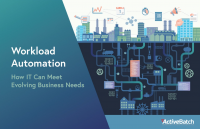Gartner Calls for More Automation: Should IT Go Low-Code?
Gartner analysts call for more automation to help manage dynamic, distributed IT environments, such as low-code automation to quickly integrate new tools.

Gartner’s “2019 Planning Guide Overview: Architecting Your Digital Ecosystem” calls for more automation as it lays out the primary trends IT must contend with.
Complexity is a growing problem for IT. Digital technologies are rapidly evolving, market demands are more dynamic than ever, and IT’s role within the organization continues to transform.
This has caused “increasingly complex technology ecosystems” that are more decentralized and distributed, making it difficult for IT to develop cohesive management and monitoring strategies.
According to Paul DeBeasi and Kirk Knoernschild, the analysts behind Gartner’s 2019 digital ecosystem guide, these are the latest trends increasing pressure on IT, including:
- Data and analytics
- Machine learning and artificial intelligence
- Cloud computing
- The Internet of Things
- Digital transformation
In order for IT to stay ahead of business demands, IT needs to be the driving force behind the organization’s digital agenda, which means first laying the foundation for IT’s own etl automation. On this point, the Gartner analysts are clear: That foundation must include back office automation.
“Organizations must invest in automation to effectively manage the complexity of decentralized and distributed systems,” write DeBeasi and Knoernschild.

Don’t struggle to meet evolving business needs.
Learn how IT can improve operations and better meet shifting business requirements with Low-Code Workload Automation.
Machine Learning and Artificial Intelligence
In Gartner’s 2019 planning guide, DeBeasi and Knoernschild point out that data and analytics tools allow IT to generate increasing volumes of operational data. This data needs to be harnessed and applied to I&O, enabling IT to more efficiently manage resources while improving SLA success rates.
Armed with a surplus of actionable data, machine learning (ML) and artificial intelligence (AI) tools will “establish predictive and proactive operations.” This includes using ML and AI to better manage and optimize “decisions, interactions and processes in support of business and IT outcomes.”
As DeBeasi and Knoernschild write, “Machine learning and artificial intelligence will impact virtually every aspect of IT, creating a challenge for technical professionals to quickly understand, integrate and operationalize this technology.”
In order to effectively operationalize ML and AI, IT needs an automation environment capable of integrating these tools into end-to-end workflows that promote the “predictive and proactive operations” DeBeasi and Knoernschild call for.
Cloud Computing
According to Gartner, the development of cloud computing has four milestones:
- The first use of a single cloud provider
- Deploying low-risk workloads
- Expanding into multi-cloud environments
- Integrating the datacenter with the multi-cloud
Progression through these milestones is driven by the fact that cloud providers are able to innovate faster while providing better scalability than organizations can. This places an onus on organizations to leverage cloud-based infrastructures in order to remain competitive.
“Organizations must implement a cloud-first strategy with an emphasis on multi-cloud architecture,” write DeBeasi and Knoernschild. “[Organizations] must also advance the use of public cloud services to become the primary, prioritized and promoted deployment model.”
This means that organizations should run applications and workloads in the data center only when they are unable to do so in the cloud. This inverts the status-quo relationship between on-premises and cloud, while setting the stage for hybrid-cloud management.
First, however, IT will need to automate.
“Infrastructure automation and orchestration will be required to achieve agility across hybrid environments,” state DeBeasi and Knoernschild, adding that IT must develop “a set of automation components that unify operations across provider silos.”
Digital Transformation
ML, AI, and cloud computing are part of a surge in new digital technologies that are fueling the dispersal of digital systems. For the first time, digital capabilities and processes are necessary and accessible to users across the organization, and this is forcing digital ecosystems to become decentralized.
This trend towards distributed IT resources is expected to continue: “New data and analytics strategies promise to accelerate digital transformation.”
Included in this wave of new technologies is IoT. As DeBeasi and Knoernschild write, “IoT platform providers [are] placing powerful and inexpensive tools within everyone’s reach.” This further democratizes digital capabilities and expands digital systems that are already widely distributed.
In order for these systems to remain coherent and useful, IT must accomplish two goals: distributed systems need to be “composed and integrated” while “assets must become readily accessible.”
Both cases require IT Automation.
Low-Code IT Automation
Whether relying on legacy schedulers, native schedulers, or homegrown solutions, IT must rewrite custom scripts in order to update workflows. Or, if there’s a new tool or technology to integrate into the automation environment, IT must research, write, and test new custom scripts.
However, digital advancements are pushing IT to quickly adopt new technologies, and custom scripts can’t keep pace with these changes because custom scripts are, after all, time-intensive and error-prone. Digital evolution is happening quickly; custom scripts have never happened quickly.
The solution, as we’ve seen, is a Low-Code IT Automation solution that provides hundreds of prebuilt, pretested Job Steps, allowing IT to quickly build complex workflows without the need for custom scripts.
Low-Code automation enables IT to quickly and seamlessly integrate a wide range of digital tools and technologies; whether by using prebuilt Job Steps, out-of-the-box integrations, or by loading third-party APIs, IT can effortlessly design a layered automation environment through which IT can monitor and manage dozens of tools and platforms.
According to DeBeasi and Knoernschild, digital advancements will “drive IT to adopt new technologies and roles.”
IT can’t rely on custom scripts to achieve digital transformation, just like it can’t rely on patchwork automation infrastructure. What IT needs is a low-code automation solution (or a no-code automation solution) that can integrate and coordinate workflows from dozens of technologies across the organization.
Ready to simplify your data warehousing with workload automation?
Schedule a demo to watch our experts run jobs that match your business requirements in ActiveBatch. Get your questions answered and learn how easy it is to build and maintain your jobs.







